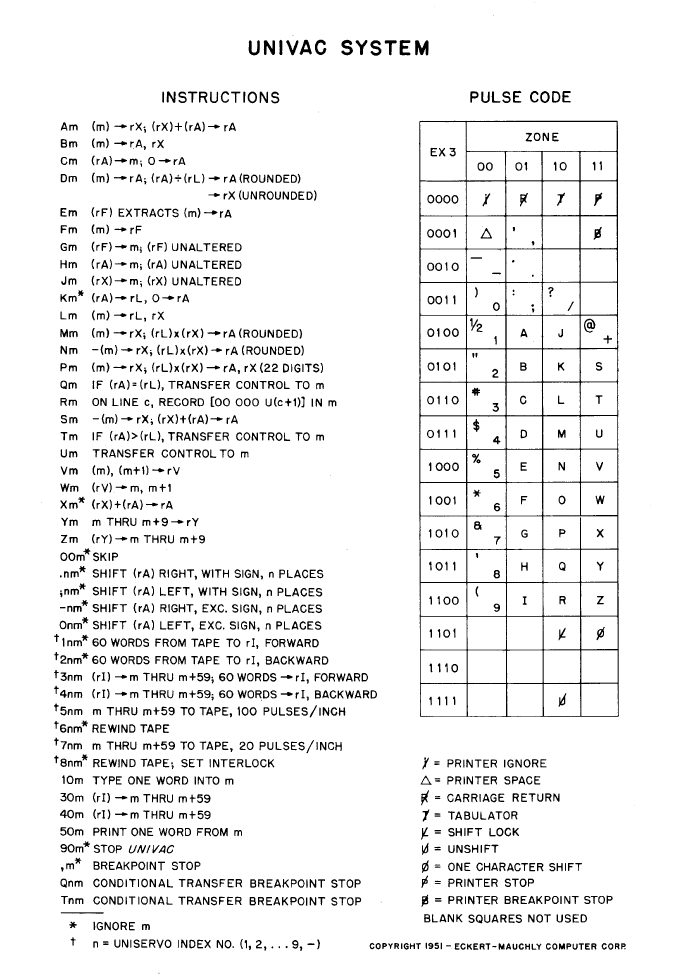C-10(ID:5442/c::011)
First Mnemonic codeset
Holberton's instruction code for the BINAC, the first to use Mnemonic code.
It was said by Hopper to be "the basis for all subsequent programming languages" (She also said Holberton "was the best programmer" that she had ever known) Bergin 2000
from WTI:
"What are you most proud of?
The design of the instruction code of UNIVAC 1 and the code called C-10. I was in engineering in those days and I had just come from programming the ENIAC. That code was mostly designed at night while I was laying awake. My daughter said it was a form of psychology. I always stayed in the background and got most things done without people knowing that. I had to learn to speak out and it effects me today. We have sessions at the nursing home and I speak up and they all sit there."
From WP Obit:
"Late in life, Mrs. Holberton was credited for her efforts to make the language and equipment of programming user-friendly. After World War II, she created an instruction code, called C-10, that allowed for control of the new UNIVAC -- the first general-purpose computer -- by keyboarded commands rather than by dials and switches.
While engineers focused on the technology of computing, Mrs. Holberton lay awake nights thinking about human thought processes, she later told interviewers.
She came up with language using mnemonic characters that appealed to logic, such as "a" for add and "b" for bring. She designed control panels that put the numeric keypad next to the keyboard and persuaded engineers to replace the UNIVAC's black exterior with the gray-beige tone that came to be the universal color of computers."
Abbott (1995) "The C-10 Code simply listed the instruction set of for UNIVAC. It also contained a simplistic chart of the timing cycles of the UNIVAC (alpha, beta, gamma, and delta time). Gamma and delta was when the instructions were executed. Alpha and beta time took care of stepping from one instruction to the next instruction, and initializing the instruction execution process."
Wikipaedia lists Ida Rhodes as a co-creator
People:
Related languages
| ENIAC short code | => | C-10 | Influence | |
| C-10 | => | A-0 | Compiled to | |
| C-10 | => | ACOMCAS | Evolution of | |
| C-10 | => | ARITH-MATIC | Compiled to | |
| C-10 | => | B-0 | Compiled to | |
| C-10 | => | MATH-MATIC | Compiled to | |
| C-10 | => | SAP | Influence | |
| C-10 | => | X-1 | Evolution of |
References:
in [ACM] CACM 1(07) July 1958 view details
In those days, programming was not at all like it is today. Each of us was given a copy of the C-10 code, which was published by UNIVAC. It probably wasn't even thirty pages in length.
The C-10 Code simply listed the instruction set of for UNIVAC. It also contained a simplistic chart of the timing cycles of the UNIVAC (alpha, beta, gamma, and delta time). Gamma and delta was when the instructions were executed. Alpha and beta time took care of stepping from one instruction to the next instruction, and initializing the instruction execution process.
The C-10 code was the only training we received. The drill was: Read the C-10 manual; Write a program. That was the way everyone started.
It was not an assembly language. This was machine code, consisting of a letter (A for add, S for subtract, M for multiply, etc.), and an address. Addresses ranged form 000 to 999. The UNIVAC contained 1,000 words of 12-characters each - 60 bits per word. The machine's architecture used Excess-3 notation - a binary arithmetic wherein zero was represented by the binary three.
in [ACM] CACM 1(07) July 1958 view details
in [ACM] CACM 1(07) July 1958 view details
Resources
- WITI Interview 1997
external link - Reference card from 1951
